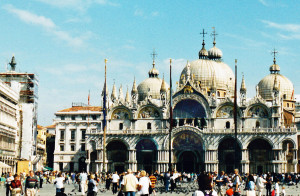Venice, encompassing 188 islands strung together by about 400 bridges, is perhaps the most unusual city in the world, with canals serving as roads, boats serving as buses, and gondoliers serving as aphrodisiacs. From catching the water taxi docked at the airport to buying gelato from a street vendor to watching glass blowers create pieces of art in nearby Murano, nearly everything about the Venetian experience is unique. More than 20 million visitors a year crowd colorful St. Mark’s Square, where they mingle with jugglers, dancers, musicians, live statues and pigeons. Unknown to most of those visitors, for more than a thousand years Venetians have shared with Egypt their most prized possession — the bodily remains lying in the magnificent Basilica of St. Mark, often called “The Church of Gold.”
Venice became a major maritime city-state during the middle ages, its power and wealth on display today in the palace of the dogeswho once ruled it. But in the early part of the ninth century, Venice lacked a suitable Christian relic commensurate with its growing power. So, in 832 A.D., Venetian merchants crossed the Mediterranean to Alexandria and stole the body claimed to be that of St. Mark, whom Egyptian Christians believe founded their church in 48 A.D. The remains were smuggled out of Egypt in a barrel of pork so the Muslim rulers of Alexandria would not inspect it. Or at least so goes the story reflected in thirteenth century mosaics on the front of the Basilica of St. Mark, built in the eleventh century on the site of an earlier church of the same name that had been constructed especially to hold the saint’s body.
The body of St. Mark is not all that was stolen in connection with the Basilica of St. Mark. The four nearly life-size copper horses that overlooked St. Mark’s square until they were retired to the museum and replaced with copies were looted from fellow Christians in Constantinople during the Fourth Crusade. Jewels adorning the altar of the Basilica may have pillaged from the Holy Lands during earlier Crusades.
Egyptian (“Coptic”) Christians have long accepted the idea that the body of St. Mark now lies in Venice, but insist that the thieves somehow left his head behind, where it remains preserved in St. Mark’s Coptic Orthodox Church in Alexandria. In 1968, Pope Paul VI, considered the successor of St. Peter by Roman Catholics, delivered to Pope Cyril VI, considered the successor of St. Mark by Coptic Christians, a bone fragment from Venice to rejoin the head in Alexandria. In such small steps does interfaith understanding and reconciliation begin.

Comments are closed.